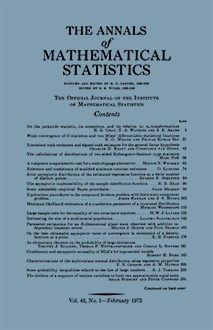Abstract
It is now widely recognized that from the point of view of robustness, nonparametric tests, such as the Wilcoxon or normal scores test, should be used in practice for the two-sample location problem instead of the classical $t$-test. But until recently there were no robust estimates for the difference between the two location parameters. In a recent paper [4] Hodges and Lehmann proposed a solution for this problem. After this paper it is clear that all the arguments that can be used in favor of the Wilcoxon test as against the classical $t$-test can be used in favor of the estimate $\operatorname{med} (Y_j - X_i)$ for the difference between the locations as against the classical estimate $(\bar Y - \bar X)$. In their paper quoted above, Hodges and Lehmann propose a whole class of nonparametric estimates corresponding to a class of nonparametric tests both for the two-sample and the one-sample location problems. To indicate this correspondence suppose $h(X, Y)$ is a test-statistic, nonparametric or otherwise for the equality of the locations of $X$ and $Y$. After having observed $(X, Y)$ we estimate the difference between the two location parameters by the amount of shift required to match the samples $X$ and $Y$ in such a way that $h(X, Y)$ is close to its expected value when the shift is zero. For a more precise definition of the estimates the reader is referred to (1.2) below. For a corresponding definition of the one-sample estimates the reader is referred to (3.3). Since the difference between the two one-sample estimates for location is an estimate for the difference between the two location parameters in the two-sample problem the paper of Hodges and Lehmann throws open a whole class of estimates for location in the two-sample problem. The aim of this paper is two-fold. First, how do these estimates compare among themselves in the Behrens-Fisher situation where the scale parameters of the populations can possibly differ? Second, how do these estimates compare with the classical estimate when the scales differ? A basic requirement to be able to answer the above questions is the asymptotic normality of the estimates in the Behrens-Fisher situation and this is shown under fairly general conditions in Sections 2 and 3. In answer to the first question the following main result is proved: If the $\Psi^\ast$-score test is the best linear rank order test when the underlying distribution is $F^\ast$ then the difference between the two one-sample estimates based on the $\Psi^\ast$-score test is more efficient than the simultaneous two-sample estimate based on the $\Psi^\ast$-score test. It follows as a particular case that the difference between the two one-sample estimates based on the normal scores test is more efficient than the simultaneous two-sample estimate based on the normal scores test when the prototype distribution is normal. In answer to the second question, the following result is shown. The differences between the one-sample Hodges-Lehmann estimates has all the advantages over the classical estimate in the case of inequality of variances as in the case of equality of variances. For a more precise statement the reader is referred to the end of Section 4.
Citation
P. V. Ramachandramurty. "On Some Nonparametric Estimates for Shift in the Behrens-Fisher Situation." Ann. Math. Statist. 37 (3) 593 - 610, June, 1966. https://doi.org/10.1214/aoms/1177699453
Information





